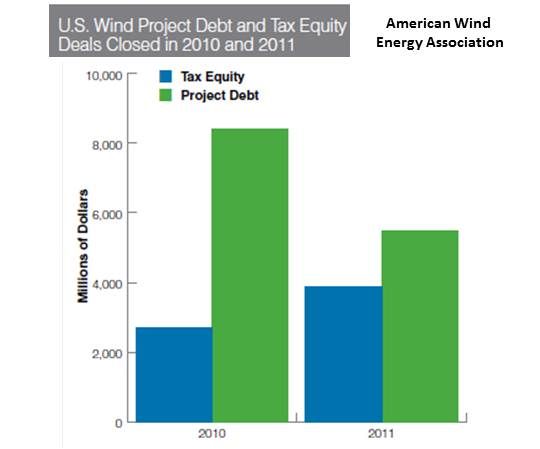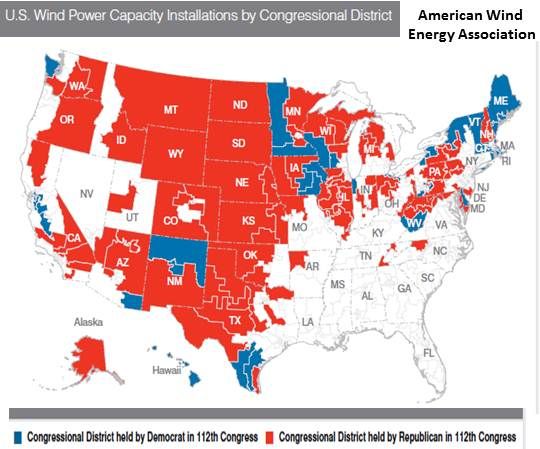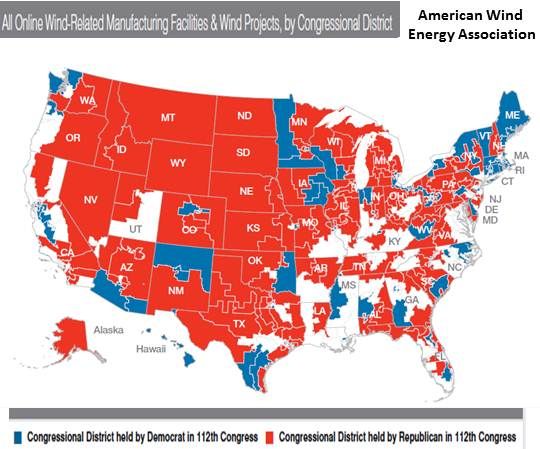The wind industry, in an uphill fight to save its federal incentive, just released its final report on 2011.
Wind was 31 percent of new U.S. generating capacity last year. All renewables accounted for 39 percent. Natural gas was 42 percent, according to American Wind Energy Association (AWEA) Chief Economist Elizabeth Salerno.
Wind added almost seven gigawatts of new capacity in 2011, about the same as seven nuclear reactors. (Nuclear added none.) It is the kind of growth wind has sustained since the middle of the last decade, when the Bush administration established some certainty about the availability of the production tax credit (PTC).
With an average annual investment of $15 billion in the subsequent five years, the U.S. industry now has almost 47 gigawatts of installed capacity in 38 states and 472 manufacturing facilities in 42 states that provide 30,000 of the 75,000 U.S. wind industry jobs.
In 2005 to 2006, only about 35 percent of the value of a wind turbine installed in the U.S. was made in the U.S.; last year, it was over 65 percent.
The key driver behind wind’s growth has long been the Production Tax Credit (PTC), which allowed it to leverage private capital. During the recession, the availability of private capital waned and the Bush and Obama administrations upped federal support in the form of a long-term extension of the PTC and a cash grant option.
With tax equity liquidity returning, conservative Republicans in Congress have not only withdrawn the cash grant option, but are refusing to extend the tax credit incentive.

This is tantamount to a tax increase on developers and, as with any tax increase, its ramifications penetrate the national economy. “Across the U.S.,” AWEA reported, “all 50 states currently have an operational wind project, a wind-related manufacturing facility, or both.” That means a lot of economic activity, i.e., jobs, revenues, direct and indirect benefits, that came from the wind industry last year are going to be compromised by this tax increase.
“At the end of 2011, 40 percent of all members of the U.S. Congress (Representatives and Senators) had wind turbines installed in their districts or states. Among the Congressional districts, over 81 percent of all wind capacity is installed in districts currently held by Republicans during the 112th Congress, over 16 percent in districts currently held by Democrats,” the AWEA report noted. “During the 112th Congress, 74 percent of the districts held by a Republican and 45 percent of districts currently held Democrat have either a wind project or a wind-related manufacturing, or both.”

Most significantly -- and this is the Stat of the Day -- the top five congressional districts in the country for wind are all Republican districts.

The U.S. wind industry is capable of adding 13 gigawatts of wind a year and providing 20 percent of U.S. electricity by 2030.
But policy certainty that promises support, Bode said, creates a “positive feedback loop” by driving development. That drives local manufacturing capacity. That results in reduced energy costs, both by eliminating most of the 18 percent to 20 percent of cost that comes from transport, and by nurturing innovation. The lower costs complete the loop by driving more development.
Yet, “there are no projects on the table for 2013 and developers are not proceeding, because the PTC has not been extended,” Salerno said. “We are ready to go. We just need the signal from Congress.”



